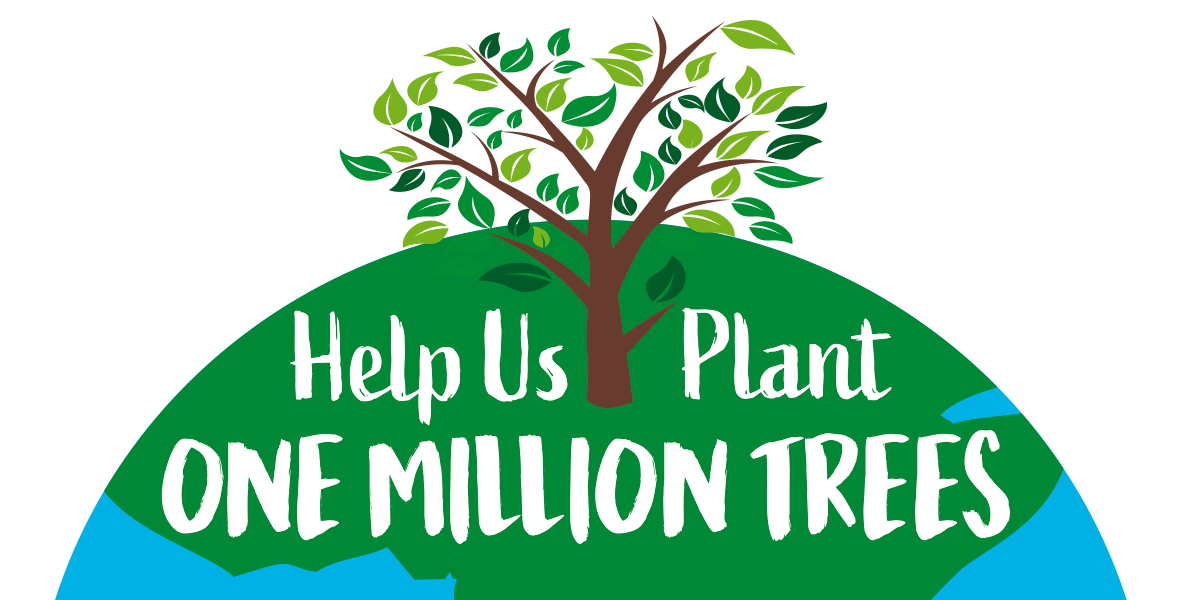
Tree Directory
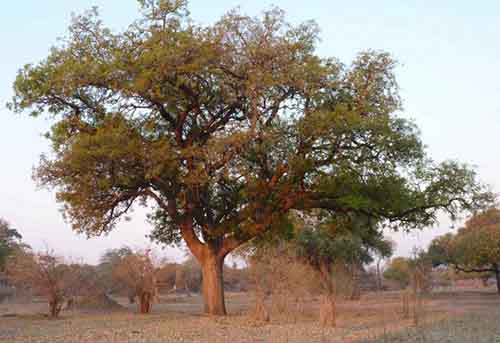
Faidherbia Albida
Self Help Africa planting in Malawi, Zambia, Ethiopia and Burkina Faso.
Faidherbia is the ideal tree to intercrop with cereal crops like maize, sorghum, and millet. In Zambia for example, maize yields were 3 tonnes per hectare under Faidherbia canopies and only 2 tonnes per ha. outside the canopies.
This tree has a unique “Reverse phrenology”, meaning it produces leaves in the dry season and sheds leaves in the rainy season. Also, the tree is able to take nitrogen, an essential fertiliser, out of the atmosphere through bacteria that grows on its roots.
Where this tree grows spontaneously, farmers protect the seedlings that naturally emerge. This is a system promoted by Self Help Africa in all projects – known as Farmer Managed Natural Regeneration (FMNR), where farmers are trained and supported in managing their resources to maintain and improve their land, farms and livelihoods.
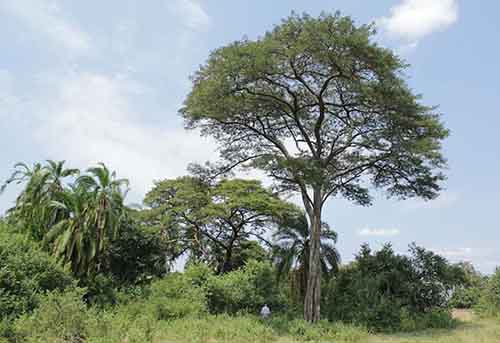
Acacia polyacantha
Self Help Africa planting in Malawi
The variety of Acacia is very important to to the farming communities Self Help Africa works with in Malawi. The trees are primarily used for conservation of catchments - areas where the rainwater collects and usually drains off into a waterbody (like a river, pond or lake). Planting trees in these catchment areas will help to improve the supply of water that will be used for domestic and agricultural needs.
Forested catchments will also help to reduce soil erosion and to buffer watercourses from pollution; to stabilise river banks, reducing bank erosion; and planting trees can help reduce flooding, and slow down flood water during flood events.

Gliricidia
Self Help Africa planting in Malawi
Gliricidia is a fast growing tree common to southern and eastern Africa. The trees are planted for 'intercropping'; to provide fodder, and improve soil fertility.
When intercropped with maize, Gliricidia is cut back in the growing season to prevent competition with the maize crop for water, light and nutrients, and the cut leaves are used as mulch - to fertilize the soil.
Once the maize has been harvested, Gliricidia is allowed to re-grow to provide vital fodder for livestock during the dry season.
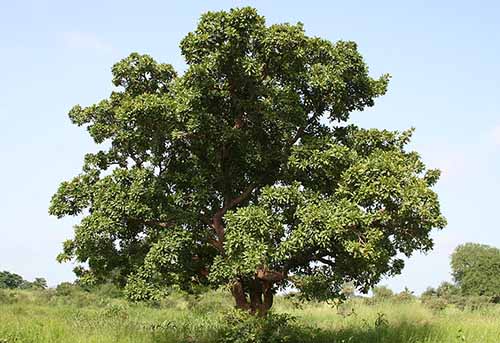
Neem (Azadirachta indica)
Self Help Africa planting in Ethiopia and Burkina Faso
Neem is a fast-growing and long-lived evergreen tree that can grow to 15 metres tall with a wide-spreading, dense crown that provides year-round cool shade in even the hottest places.
A true multipurpose tree, neem is a very valuable plant to grow. It is a very effective medicinal herb for treating fevers, provides food, a very good insecticide and insect repellent (sleeping under a neem tree keeps away mosquitoes and neem headlice treatment is sold in the US!). In Africa, farmers also use neem leaves in grain stores to deter insects. In the hot and dry countries of the Sahel, Neem is often planted along streets to provide shade.
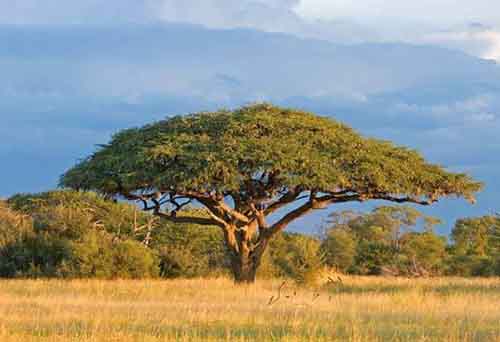
Acacia senegal
Self Help Africa planting in Ethiopia and Burkina Faso
This may not be a name you're familiar with but almost everyone has tasted its product! The Acacia Senegal produces Gum Arabic - used by the food industry as a stabilizer, emulsifier, and thickening agent in icing, fillings, soft candy, chewing gum, and other confectionery, and to bind the sweeteners and flavorings in soft drinks!
In Africa - the Acacia Senegal grows in semi-arid areas, in countries like Burkina Faso and Ethiopia, where other agriculture can be quite fragile. Sap collection (the 'gum') provides employment and income for farmers, while the leaves and fruit give fodder for sheep and goats, and the roots help fix nitrogen in the soil.
Self Help Africa has also established several beekeeping projects in the communities where the Acacias grow, and the tree flowers provide nectar for those bees. This results in delicious nutritious honey that families eat at home and sell to earn extra income.
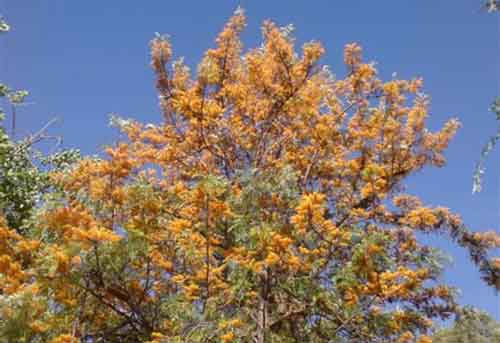
Silky oak (Grevillea robusta)
Self Help Africa planting in Kenya and Uganda
The Silky Oak is an erect, single-stemmed tree typically reaching 20-30 m tall and 80 cm in diameter. Grevillea is one of the most important trees in the tropical highlands of East and Central Africa.
It is commonly planted as a boundary tree around the perimeter of small farms, in a single row at 2-2.5 m spacing. It is also planted in rows between small fields, and as scattered individuals over crops such as coffee and maize.
This tree is also planted in rows along the contour to conserve soil on sloping lands in the tropical highlands. There is also some evidence to show that using the leaves as a mulch can reduce soil losses on sloping land.
For the farmers Self Help Africa works with in these upland regions, being able to protect and nourish the soil is vital to improve farm yields and income.
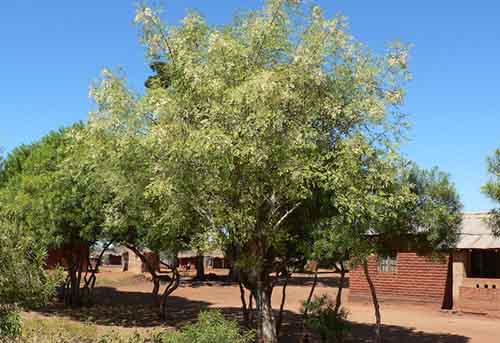
Moringa, drumstick tree (Moringa oliefera)
Self Help Africa planting in Ethiopia, Zambia, Uganda, Malawi, Kenya
Although native to Asia, Moringa is widely grown in Africa, where its leaves are used in cooking, much like we would use spinach. The pods are cooked like green beans and the seeds from more mature pods are cooked like peas or roasted like nuts.
Moringa grows quickly and is drought resistant. The dried leaves retain lots of vitamins and minerals.
The farmers Self Help Africa works with in East and Southern Africa are encouraged and trained in growing moringa as a way to improve child and maternal nutrition.
Oil from moringa seeds is used in foods, perfume and hair care products, and as a machine lubricant. The seed cake remaining after oil extraction is used as a fertilizer and both the seeds and the seed cake have the unique ability to purify water.
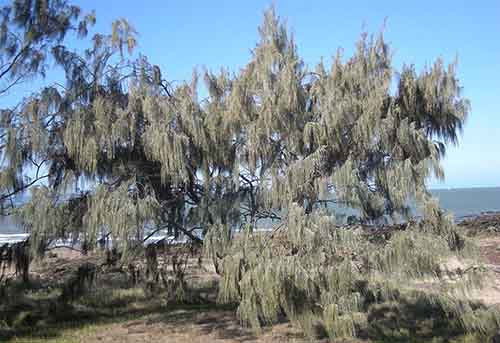
Casuarina equistifolia, (also known as beech she-oak, common ironwood)
Self Help Africa planting in Kenya
Casuarina is a remarkable evergreen tree with a finely branched, feathery crown. Unlike most trees, Casuarina is salt tolerant and grows well in sand, so it can be used to control erosion along coastlines, estuaries, riverbanks and waterways, and to stabilise sand dunes.
It is often planted for reclaiming and improving the land. Its abundance of highly branched twigs absorbs wind energy amazingly well; in areas with hot, dry winds, the tree protects crops and animal herds.
Casuarina fixes atmospheric nitrogen through symbiosis with a root fungi. Because of this partnership, Casuarina is able to grow vigorously on barren, polluted sites and thrive in deep sandy soils.
Casuarina is idea for planting on field boundaries in arid and semi-arid areas as it does not shade the crop very much, adds nitrogen to the soil and yields substantial quantities of green leaf manure on lopping. SHA is planting Casuarina in sandy areas in Kenya, especially along the coast.
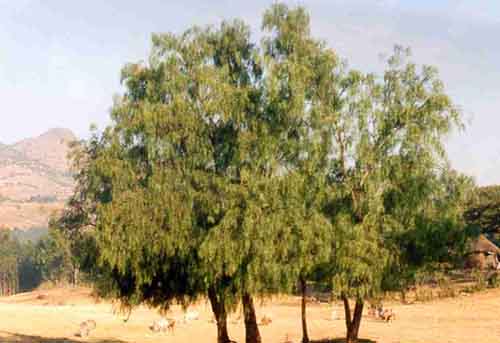
Peruvian pepper tree (Schinus mole)
Self Help Africa planting in Ethiopia
The Peruvian Peppertree is a fast growing, elegant evergreen tree with a wide crown of weeping foliage between 6 to 15 metres tall. It produces flowers from April to June and is one of the few trees that will contain male only or female only flowers, where separate male and female plants must be grown if further seed is required.
The Peppertree is used for food - its lush red berries can be dried and roasted and used as a pepper substitute. On a larger scale, the fruit can be distilled to create an oil which is used in spiced baked goods, chewing gum and candy.
Farmers working with Self Help Africa plant the Peruvian Pepper tree to restore degraded land areas in Ethiopia.
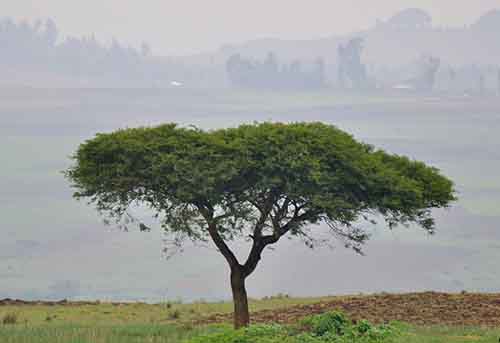
Umbrella thorn (Acacia abyssinica)
Self Help Africa planting in Ethiopia
Familiar to everyone who has watched wildlife documentaries or movies like “The Lion King” and “Out of Africa”, probably no other tree symbolises the African savannas as much as flat topped Umbrella Thorn.
Found in Africa from Ethiopia to Mozambique and Zimbabwe, the Umbrella Thorn is drought tolerant, produces its own nitrogen and will grow on degraded land and along gullies, making it a good species for restoring degraded land. The Umbrella Thorn provides an edible gum, medicine, fodder and shade for livestock and the well-known acacia honey. The Umbrella Thorn is one of the species that SHA plants to help restore degraded land areas in Ethiopia.
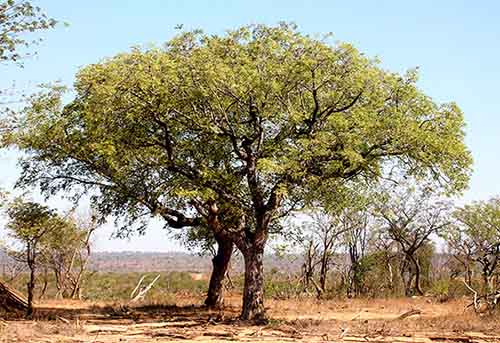
Marula (Sclerocarya birrea)
Self Help Africa planting in Malawi and Zambia
Marula is a medium-sized deciduous tree, indigenous to Southern Africa, the parklands of the Sahel and Sudan, and Madagascar.
Collecting the fruit of wild marula tree is an important source of income for women in rural communities. The fruit is eaten at home, and sold at market; and the juice and pulp are mixed with water and fermented to make traditional marula beer. There are local tales of elephants becoming drunk on the fallen and fermented fruits!
Commercially the frozen fruit puree is used in juice blends and marula oil is used as an ingredient in cosmetics as a skin moisturizer and as an edible oil in Southern Africa.
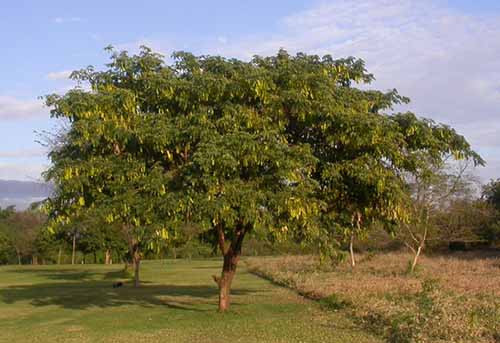
Albizia lebbeck
Self Help Africa planting in Malawi
Albizia lebbeck has been commonly called the ‘Woman’s Tongue Tree’ or the ‘Shak Shak tree’. These names come from the rattling sound the seeds make inside the pods when it is windy. These seeds are edible and can be harvested when the pods turn yellow. They are dried in the baking sun before they go brittle and can be beaten with a flail to be extracted and combined in a meal.
This tree can grow to 30m in height and produces large white flowers which are very fragrant and delicate looking.
Self Help Africa plants Albezia for shading crops like coffee and banana, for shelterbelts and for providing nitrogen to crops. Albezia also provides fodder for small livestock.
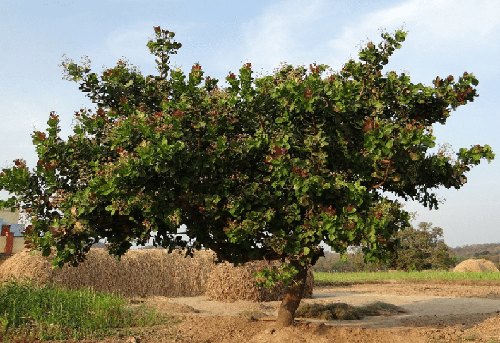
Cashew (Anacardium occidentale)
Self Help Africa planting in Kenya, Zambia and Burkina Faso
Familiar to everyone, the cashew is a tropical evergreen tree that can grow up to 14 metres, and the smaller dwarf species reaching 6 metres. There are over 600 species in the Anacardium family, including mango and pistachio) but the cashew is by far the most economically important.
The Cashew tree is mainly grown in the wet and dry tropics where it can withstand temperatures of over 100 degrees. They are excellent trees for warmer regions and are quite drought resistant. SHA is promoting the planting of new cashew orchards and the rehabilitation of old orchards in Kenya, Zambia and Burkina Faso. New orchards and old trees are being replaced with dwarf varieties as these can produce economic yields after three years, compared with up to eight years for the traditional species.
To improve both soil fertility and household nutrition, SHA has developed a system of planting beans between the cashew trees.
The cashew nut is very unusual as it hangs underneath the cashew apple, rather than being hidden inside the fruit. The cashew apple matures in 90 days, can be eaten fresh, is high in Vitamin C and has a refreshing, sweet taste. Cashew apples are also used to make the alcoholic drink ‘Feni’.
The cashew nut is high in protein and is eaten across the world. Export demand is high and cashew nuts are a very valuable export crop.

Desert date (Balanites aegyptiaca)
Self Help Africa Planting in Burkina Faso
Balanites aegyptiaca is found across the Sahel-Savannah region of Africa. Balanites is valuable in arid regions because it produces fruit even in dry times. The yellow, single-seeded fruit is edible but bitter. Some trees have unusually sweet fruit and these can be grafted onto the roots of bitter trees.
The fruit can be mixed into porridge to be eaten by nursing mothers and is sometimes fermented for alcoholic drinks. Other parts of the tree are used as food during the ‘hunger gap’. The leaves are eaten raw or cooked, the oily seed is boiled to make it less bitter and eaten mixed with sorghum, and even the flowers can be eaten.
Another important use for the Desert Date is the control of the parasites Bilharzia and Guinea worm. These parasites are spread by water snails and copepods. Bilharzia is particularly widespread in the tropics wherever people are in contact with lakes and wetlands: farmers irrigating their crops, fisherfolk, children playing. The bark and fruits of the Desert Date repel and kill the snails and copepods. As a result, Balanites is often planted on the border of irrigation canals and rivers so that the fallen fruits control the bilharzia-carrying snails.
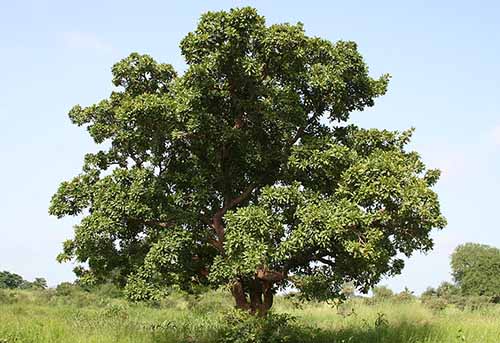
Shea nut (Vitellaria paradoxa)
Self Help Africa planting in Malawi and Zambia
The Shea Nut Tree is an important part of the economies of the countries of the Sahel, and is Burkina Faso’s third most important export, after cotton and livestock.
In West Africa, shea nut cultivation is particularly important for women, as they control the shea nut butter value chain. Self Help Africa works with women farmers in Burkina Faso to plant and protect shea nut trees, helping women maintain and earn an independent income, even in the drier seasons.
The tree starts producing nuts when it is 10 to 15 years old and can produce nuts for up to 200 years. The fruits resemble large plums and an average tree can produce 15 to 20 kilograms of fresh fruit per season.
An edible oil is extracted from the nuts that has the texture of butter at room temperature. Shea Nut butter is used for cooking and as an ingredient in chocolate. But it's also well known for its use in cosmetics, for example skin moisturizers, hair conditioners, lipsticks and lip gloss.
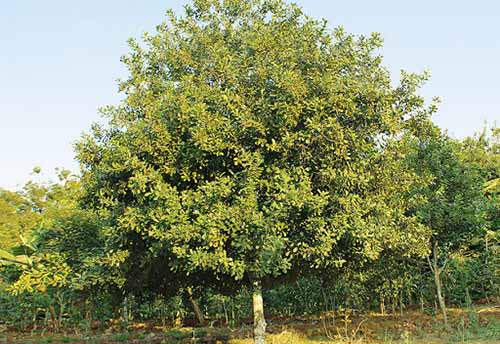
Macadamia (Grevilleoideae)
Self Help Africa planting in Malawi, Kenya, Uganda
Macadamia is an evergreen tree that grows up to 12 metres in height. The genus is comprised of four species but all produce the same fruit, which is more commonly known as the macadamia nut. The tree takes between five and eight years before producing its first fruit. Once the nuts are ripe they fall from the tree and can be easily picked from the ground. Even with this easy harvest, only a few nuts get produced on each tree each year which makes macadamias most expensive nut in the world!
Malawi and Kenya have established macadamia industries, and Uganda is catching up.
Macadamias produce an oil which can be as high as 80% fat content. This oil is commonly used in cooking and cosmetics.
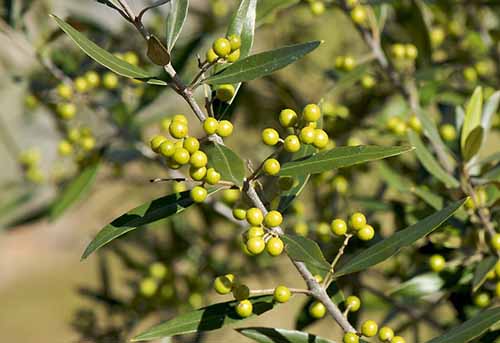
African Olive (Olea europaea subsp. africana))
Self Help Africa planting in Ethiopia
The African Olive is a subspecies of the European Olive, a neatly-shaped evergreen tree with a dense spreading crown (9 x 12 m) of glossy grey-green to dark-green foliage. It has strong smelling white flowers from July to March, which are quickly followed by a glossy fruit that ripens from green to red to black.
The olives are usually made into a non-drying oil which is used on salads and in cooking. The fruits are also a popular food for native wild animals, such as monkeys, baboons, mongooses, bushpigs, warthogs, bats and birds.
The African Olive tree is an asset on farms in very dry areas because it is extremely hardy and is an excellent fodder tree for livestock. Unfortunately, the African Olive is becoming endangered, so Self Help Africa plantings will act as a conservation measure for this traditional species.
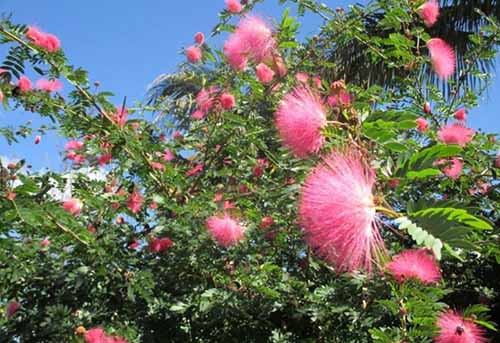
Calliandra calothyrsus
Self Help Africa planting in Uganda
As known by locals as “Powderpuff”, Calliandra is a small, fast-growing shrub that produces flowers that look like umbrella clusters. Calliandra produces a beautiful pink-coloured flower during the dry seasons of June to September. This colour attracts lots of bees and the honey made from Calliandra calothyrsus has a unique sweet taste. Calliandra is one of the favourite flowers of sunbirds, the stunning African ecological equivalent to the American Hummingbirds.
Calliandra produces its own nitrogen, and grows in many areas, including less fertile soils, which makes it a brilliant addition to the African landscape. Self Help Africa is planting Calliandra calothyrsus for the rehabilitation of erosion prone areas in Uganda and to provide nitrogen for crops. Calliandra is commonly planted in small villages as strips of hedgerow - this protects against fire and illegal wood cutting.
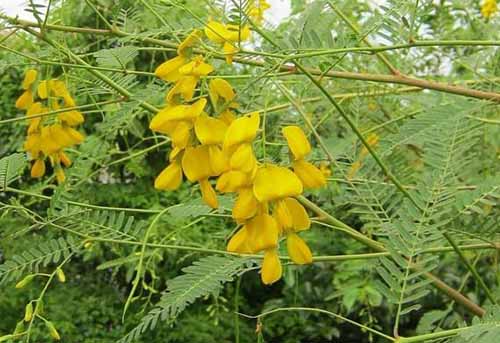
Sesbania sesban
Self Help Africa planting in Kenya and Uganda
Riverhemp is the common name for plants in the Sesbania family. Sesbania is a small but fast growing tree that grows to about 5 metres in height after only 6 months!
Sesbania produces its own nitrogen and Self Help Africa encourages farmers to grow this tree as an ‘intercrop’ with maize, bean and cotton in Kenya and Uganda to reduce the need for farmers to buy nitrogen fertilisers.
The yellow flowers are used for decorative purposes and can also be eaten as a vegetable. The fresh seeds are poisonous to humans but they can be eaten if they are soaked for 3 days and then cooked. They can also be ground into a fermented paste known as ‘Soumbara’.
Locally, the leaves are used to treat scorpion stings, boils and abscesses where they are considered to have antibiotic properties. The seeds can also be made into an antibacterial medicinal oil which is widely used amongst small communities.
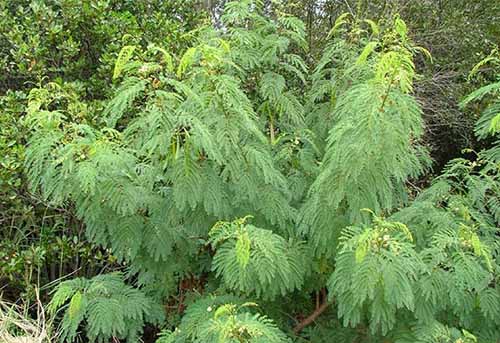
Leuceana leucophala (White Lead Tree)
Self Help Africa planting in Malawi
Self Help Africa Planting in Ethiopia, Kenya, Malawi, Zambia, Uganda
Leucaena leucocephala, or more commonly known as ‘White lead tree’, is a fast-growing evergreen tree that can grow up to 20 metres tall, produces its own nitrogen and can be repeatedly cut back. Leucaena is widely cultivated for shade, animal feed, firewood and soil fertility.
The young pods are edible and are high in protein. They can be used for cooking, where they are commonly found in spicy dishes.
Self Help Africa is working with farmers to plant Leucaena in their fields to stabilise the soil, fertilise crops and feed small livestock such as goats.
